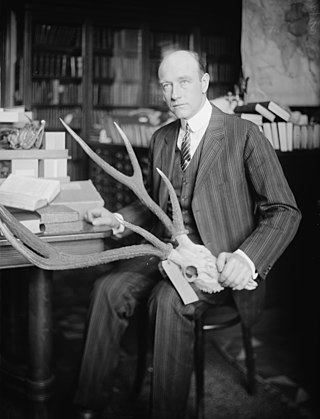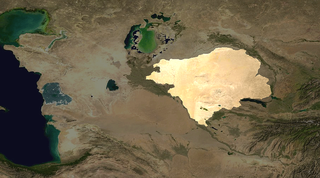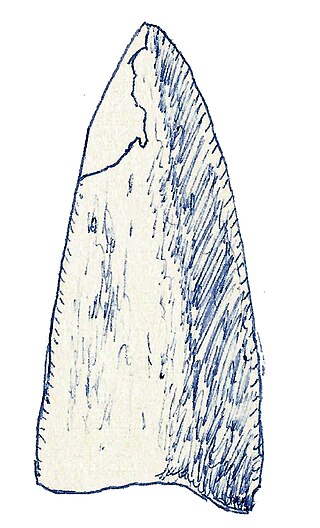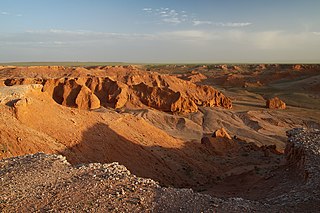
Roy Chapman Andrews was an American explorer, adventurer, and naturalist who became the director of the American Museum of Natural History. He led a series of expeditions through the politically disturbed China of the early 20th century into the Gobi Desert and Mongolia. The expeditions made important discoveries and brought the first-known fossil dinosaur eggs to the museum. Chapman's popular writing about his adventures made him famous.

The Kyzylkum Desert is the 15th largest desert in the world. Its name means Red Sand in Turkic languages. It is located in Central Asia, in the land between the confluent rivers Amu Darya and Syr Darya, a region historically known as Transoxania. Today it is divided among Kazakhstan, Turkmenistan and Uzbekistan. It covers about 298,000 km2 (115,000 sq mi).

Zuniceratops is a genus of ceratopsian dinosaurs that lived during the Turonian stage of the Late Cretaceous in what is now New Mexico, United States. Only a single species is known, Zuniceratops christopheri.

Bagaceratops is a genus of small protoceratopsid dinosaurs that lived in Asia during the Late Cretaceous, around 72 to 71 million years ago. Bagaceratops remains have been reported from the Barun Goyot Formation and Bayan Mandahu Formation. One specimen may argue the possible presence of Bagaceratops in the Djadochta Formation.

The Bayan Shireh Formation is a geological formation in Mongolia, that dates to the Cretaceous period. It was first described and established by Vasiliev et al. 1959.

Yaverlandia is a genus of maniraptoran dinosaur. Known from a partial fossil skull found in Lower Cretaceous strata of the Wessex Formation on the Isle of Wight. it was described as the earliest known member of the pachycephalosaurid family, but research by Darren Naish shows it to have actually been a theropod, seemingly a maniraptoran. The type species is Y. bitholus.

Tylocephale is a genus of pachycephalosaurid dinosaur, a group of dome-headed, herbivorous ornithischians, that lived during the Late Campanian stage of the Late Cretaceous in what is now Mongolia. It is known from a partial skull and associated mandible that were unearthed in 1971 by a Polish-Mongolian Expedition to the Barun Goyot Formation of the Gobi Desert. The specimen was described in 1974 by Polish paleontologists Teresa Maryańska and Halszka Osmólska as a new genus and species.

Tsagantegia is a genus of medium-sized ankylosaurid thyreophoran dinosaur that lived in Asia during the Late Cretaceous period. The genus is monotypic, including only the type species, T. longicranialis. The specimen consists of a very partial individual, comprising the skull and lacking postcranial remains. Since it only preserves the skull, Tsagantegia is mainly characterized by its elongated snout and the flattened facial osteoderms, greatly differing from other ankylosaurs.

Mongolosaurus is a genus of titanosauriform sauropod dinosaur which lived during the Early Cretaceous of China.

The Barun Goyot Formation is a geological formation dating to the Late Cretaceous Period. It is located within and is widely represented in the Gobi Desert Basin, in the Ömnögovi Province of Mongolia.

The Nemegt Formation is a geological formation in the Gobi Desert of Mongolia, dating to the Late Cretaceous. The formation consists of river channel sediments and contains fossils of fish, turtles, crocodilians, and a diverse fauna of dinosaurs, including birds.

The Djadochta formation is a highly fossiliferous geological formation in Central Asia, Gobi Desert, dating from the Late Cretaceous period, about 75 million to 71 million years ago. The type locality is the Bayn Dzak locality, famously known as the Flaming Cliffs. Reptile and mammal remains are among the fossils recovered from the formation.
Paleontology or palaeontology is the study of prehistoric life forms on Earth through the examination of plant and animal fossils. This includes the study of body fossils, tracks (ichnites), burrows, cast-off parts, fossilised feces (coprolites), palynomorphs and chemical residues. Because humans have encountered fossils for millennia, paleontology has a long history both before and after becoming formalized as a science. This article records significant discoveries and events related to paleontology that occurred or were published in the year 1980.
The Ulan Malgait Formation is a Late Jurassic geologic formation in Mongolia. Dinosaur remains are among the fossils that have been recovered from the formation, although as of 2004 none have yet been referred to a specific genus.

The fossil trade is the purchase and sale of fossils. This is at times done illegally with stolen fossils, and important scientific specimens are lost each year. The trade is lucrative, and many celebrities collect fossils.

Augustynolophus is an extinct genus of herbivorous saurolophine hadrosaur dinosaur which was discovered in the Moreno Formation in California, dating to the late Maastrichtian age, making it one of the last dinosaurs known from the fossil record before the Cretaceous–Paleogene extinction event.
Bolortsetseg Minjin is a Mongolian paleontologist known for her work in fossil repatriation and dinosaur-themed science outreach. She is a recipient of the WINGS WorldQuest Women of Discovery Award for Earth, National Geographic Explorer, and TEDx speaker. She is the founder of the Institute for the Study of Mongolian Dinosaurs.

Almas is a genus of troodontid theropod dinosaur from the Late Cretaceous of Mongolia. It contains a single species, Almas ukhaa, named in 2017 by Pei Rui and colleagues, based on a partial articulated skeleton. The only known specimen was found in the Djadochta Formation, which is late Campanian in age.

Natovenator is a genus of halszkaraptorine dromaeosaurid dinosaur from the Late Cretaceous Barun Goyot Formation of Mongolia. The genus is known from a single species, N. polydontus. Natovenator is crucial to the understanding of halszkaraptorines due to it providing more support for the semi-aquatic lifestyle that has been proposed for this clade. This discovery is important as the semi-aquatic lifestyles of halszkaraptorines was contested in early 2022.

















